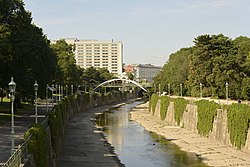This article needs additional citations for verification .(August 2013) |
| Wien | |
|---|---|
 The Wien in the Stadtpark | |
 | |
| Location | |
| Country | Austria |
| Physical characteristics | |
| Source | |
| • location | Kaiserbrunnberg near Rekawinkel in Lower Austria |
| • elevation | 520 m (1,710 ft) |
| Mouth | |
• location | Donaukanal (Danube) in Vienna |
• coordinates | 48°12′43″N16°23′04″E / 48.21194°N 16.38444°E |
| Length | 34 km (21 mi) |
| Basin size | 221 km2 (85 sq mi) |
| Basin features | |
| Progression | Danube→ Black Sea |
The Wien is a river that flows through the capital of Austria, Vienna.






